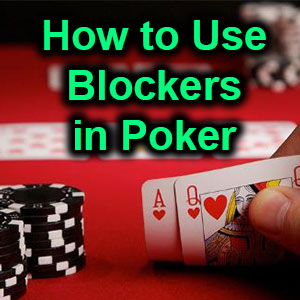You may have heard of the term Blockers being thrown around and not really know the full concept or maybe you are already a savvy GTO player and just looking to pick up some extra tips, in this article we are going to look at some tips on how we can optimise our play when holding blockers…
So What are Blockers?
This is the name given to cards that we hold that block hands that our opponent could have. They can be holdings that block our opponent’s value range like if we have 79 on a T 9 6 board, for example, we block two pair combinations with our 9 and straights with our 7 blocker.
But these aren’t the only type of blockers we want to think about, we can also block our opponents possible bluffs, for example, if we have JT on the board of T 9 2 4 A We actually have a good hand blocking hands like top two pairs and top set, however the Jack in our hand hurts us as if our opponent fires all 3 streets on this board we would like them to have bluffs like QJ, KJ, J8 etc but we block all of these holdings by holding a Jack, so in actuality we would rather have a hand like a raggy hand with a nine or ten in it when it comes to removal.
When Can We Use Blockers Pre-flop?
These come into good use when constructing a 3-Betting from a late position against another late position open.
For example:
(Blinds $1/$2)
Cut off: Raises to $6
Button: Hero has A♠ 5♠ Raise to $17
If we knew our opponent is only going to 4-Bet with the very top of their range as most players will do we can comfortably 3-Bet here to build a pot for value in position against worst holdings and even when we are against stronger holdings we will pick up the betting lead and have position for the rest of the hand, but how do blockers come in to play here?
With us holding an Ace in our hand we block a large portion of our opponents 4-Betting range which would include hands like JJ-AA including hands like AKo and AKs.
Our opponent is:
- 50% less likely to have a combination of AA as there are now only 3 Combinations left from 6.
- 25% less likely to have a combination of AKs as there are now only 3 combinations left from 4.
- 25% less likely to have a combination of AKo as there are now only 9 combinations left from 12.
So if our opponent is only 4-Betting us with hands including JJ-AA and AKo/AKs they are now 17.5% less likely to have a 4 Betting hand and this is just from us having a single Ace in our hand! So you can start to see that blockers can mean a lot when it comes to a math point of view.
So if you are looking to mix up your game with some aggression pre-flop try and factor in blockers like this rather than hands that don’t block the best part of your opponent’s range.
Using Blockers to Bluff
Having blockers to nutted hands can make good candidates to turn parts of the bottom of our value range into bluffs.
Let’s look at an example where we flop a decent hand but there are too many combinations of hands that trump us by the river so we decide to bluff rather than choosing to call or fold.
Tournament Blinds 500/1000, 100 ante
Hero (35BBs) is in the BB holding Q♣ 9♣
UTG (35BBs) raises to 2000
Table folds to us in the BB, We call 1000
Flop
T♠ 9♣ 2♠
Hero Checks. UTG bets 2000
Turn
4♦
Hero Checks. UTG Checks.
River
K♦
Hero Checks. UTG Bets 6000
Hero All in for 32,000
This hand starts with us defending our Big Blind (BB) with a solid hand in the shape of Q9s with 35BBs effective against the same sized stack from the UTG open.
This opening range is going to be tight, including many hands that have us in bad shape but for a minimum open we can defend profitably especially with the running ante in play.
On the flop we have a decent holding, flopping second pair with a back door flush draw, we start with a check, face a bet and opt to call. Raising here wouldn’t make a tonne of sense as we would just force out bluffs and increase the pot against holdings that are beating us along with open ourselves up to being forced off our equity from another raise that could come in the shape of a flush or straight draw.
The turn is checked through, which our opponent will do with a lot of there top pair part of there range for some pot control with hands like QT, JT, KT that feels like they can’t get 3 streets of value from worse hands, our opponent will also hand a bunch of hands like AK, KQ, KJ, QJ that might bet once on the flop and then just check give up turn if they don’t improve.
Once the river comes this completes a decent percentage of our opponents range such as any hand with a King in it improving to top pair, KT specifically just made top two pair, we check it to them and face what is very likely to be a value bet.
Given the action and our exact hand limiting combinations of the nuts on this river which is QJ and given the fact our opponent raises UTG QJo is unlikely to be part of that range, so there are only 3 combinations of the nuts in our opponents range alongside a slim value bet range of hands like KJ, KQ, AK, etc. We also block other value hands like K9s too.
Where some players may just look to fold here sometimes and call a small percentage of the time, we can look to exploit our opponent going for thin value alongside having the nuts blocked down to what is likely to be only 3 Combinations and apply maximum pressure in this spot, Moving all in.
Some Final Tips on Using Blockers in your Game
- Don’t go overboard!
Whilst adding some blocker consideration into your game plan is a good thing you are still going to want to consider your opponents’ whole range when looking to make moves based upon the blockers you are holding. - Don’t look to turn hands that have decent showdown value into bluffs as you will still win from making calls with this part of your range when using blockers you are going to want to turn the bottom of your range you get to the river with as possible bluffs.
- Don’t go too nuts with any Ace high blockers as you will become too aggressive and just run into hands too often, you will want to use 3-Bet or 4-Bets with blocker very selectively against the most aggressive preflop players on your table to remain balanced.

